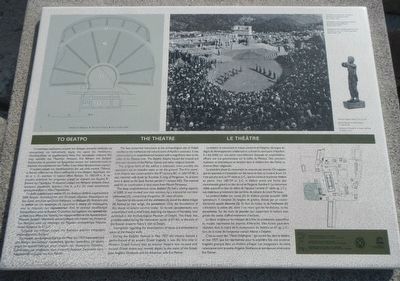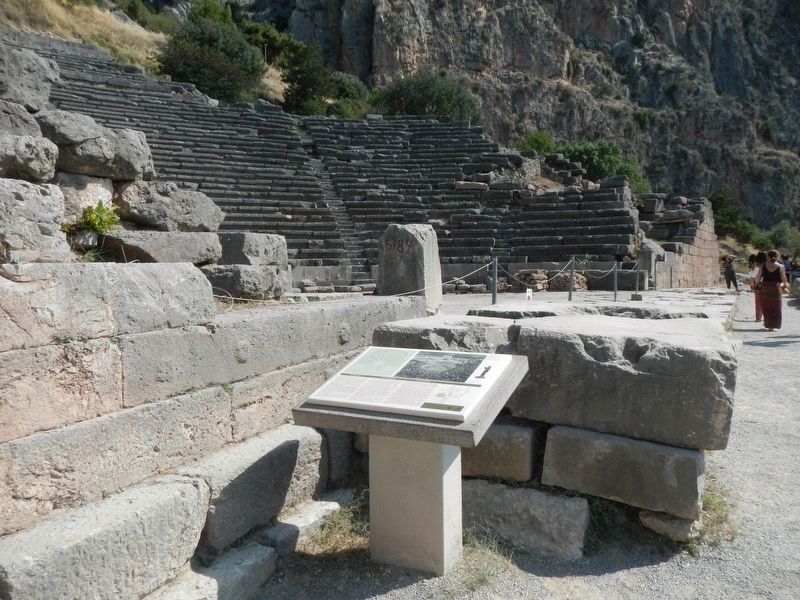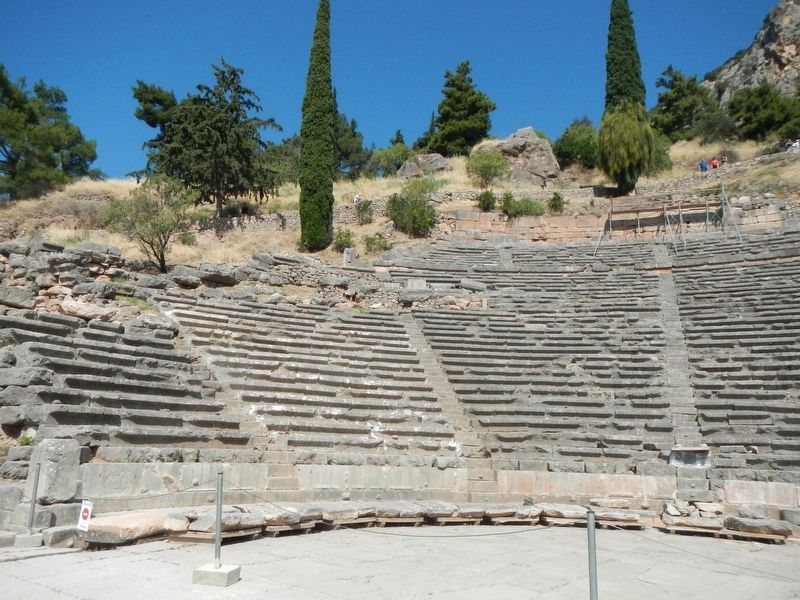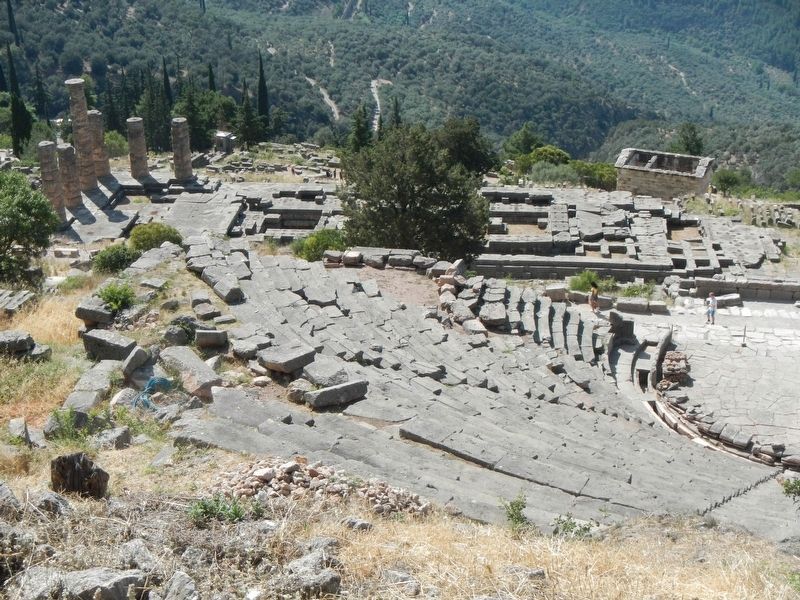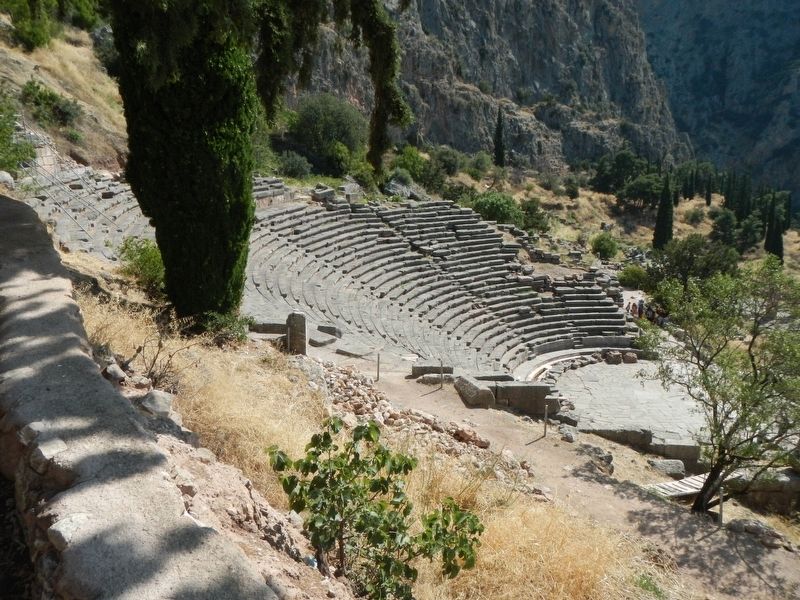Delfi in Phocis, Thessaly and Central Greece, Greece — Ελλάδα (Southeastern Europe, Balkan Peninsula)
The (Delphi) Theatre
TO ΘEATPI
— Le Théâtre —
Inscription.
The texts on this marker are written in Greek (left), English (center) and French (right). Only the English text has been transcribed. To read the Greek and French texts, enlarge the marker image by clicking on it.
English:
The best preserved monument at the archaeological site of Delphi testifies to the intellectual and cultural acme of Apollo's sanctuary. It was constructed at the amphitheatrical location with a magnificent view to the valley of the Pleistos river. The Delphic theatre hosted the musical and dramatic contests of the Pythian Games and other religious festivals.
The original form of the edifice is unknown; most possibly the spectators sat on wooden seats or on the ground. The first stone-built theatre was constructed in the 4th century BC. In 160/159 it was restored with funds by Eumenes II, king of Pergamon. Its present form is dated to the Early Roman period (1st century AD). The material used for its construction is local stone from Mount Parnassos.
The deep amphitheatrical cavea (koilon) (1) had a seating capacity of 5000. It was divided into two sections by a transverse corridor (diazoma) (2) , comprising altogether 36 rows of seats.
Opposite the cavea and the orchestra (3) stood the skene (stage) (4) flanked by two wings, the paraskenia. Only the foundation of this skene structure survive today. Its facade (proskenium) was embellished with a relief frieze depicting the labors of Herakles, now exhibited in the Archaeological Museum of Delphi. The frieze was probably added during the restoration works of 67 AD, at the time of the Roman emperor Nero's visit to Delphi.
Inscriptions regarding the emancipation of slaves are embedded in parts of the theatre walls.
During the Delphic Festival of May 1927 the theatre hosted a preformance of an ancient Greek tragedy; it was the first time in Modern Greek history that an ancient theatre was re-used and ancient Greek drama was revived, thanks to the vision of the Greek poet Angelos Sikelianos and his American wife Eva Palmer.
Erected by Greek Ministry of Culture and Sports.
Topics. This historical marker is listed in these topic lists: Architecture • Arts, Letters, Music • Man-Made Features.
Location. 38° 28.94′ N, 22° 30.026′ E. Marker is in Delfi, Thessaly and Central Greece, in Phocis. Marker can be reached from Ethniki Odos Livadias Amfissas (Route EO 48), on the left when traveling east. Touch for map. Marker is in this post office area: Delfi, Thessaly and Central Greece 330 54, Greece. Touch for directions.
Other nearby markers. At least 8 other markers are within walking distance of this marker. The Theater District (about 90 meters away, measured in a direct line); The Temple of Apollo (about 90 meters away); The Halos (about 90 meters away); The Navel (about 120 meters away); The Altar of Chiots Area (about 120 meters away); The Treasury of the Sikyonians and Siphnians (about 120 meters away); Monuments of the Sacred Way (about 180 meters away); The Roman Agora (about 210 meters away). Touch for a list and map of all markers in Delfi.
Also see . . . The Delphi Theater. In modern times the stage is larger and is the focus of attention, similar to later Roman theaters, but the stage of the Greek theater was less dominant. The depth of the stage was roughly 7 to 12 feet, hardly enough room for any actor to perform his part, so actors also used the chorus as a performance area. Single acts were generally performed by one actor who stood in the center of the orchestra, on the steps, or around the vicinity of the altar. (Submitted on November 14, 2018, by Barry Swackhamer of Brentwood, California.)
Credits. This page was last revised on March 21, 2022. It was originally submitted on November 14, 2018, by Barry Swackhamer of Brentwood, California. This page has been viewed 254 times since then and 35 times this year. Photos: 1, 2, 3, 4, 5. submitted on November 14, 2018, by Barry Swackhamer of Brentwood, California.
